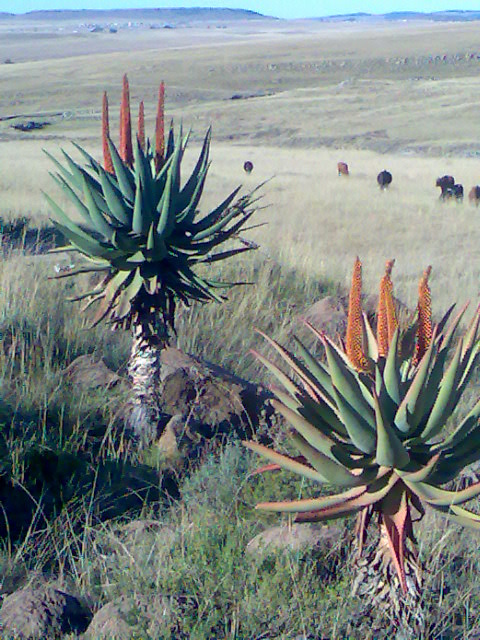Fact sheet about Aloe ferox
The Kenya Wildlife Service booklet on Strategy for Conservation and Management of Commercial Aloe Species in Kenya
Distribution and habitat
A. ferox is indigenous to South Africa and Lesotho, growing in the semi-arid open plains to rocky mountain slopes. In Kenya it is commonly cultivated in Nairobi gardens and its environs. It is distributed throughout the tropics and sub tropics where it grows as an ornamental or medicinal plant. It grows in a wide range of climatic conditions, and is especially abundant on arid, rocky hillsides up to 1000m altitude, where mean temperature ranges from 27-310C and annual rainfall is 50-300mm.
Flowering and fruiting habits
Single-stemmed plant, up to 2-5m tall with dense crown of green to red-brown succulent leaves up to 1m long, with brown spines. Stem is covered with persistent dried leaves. Flowers are bisexual, about 10 cylindrical racemes on a branched panicle, long with dark orange stamens protruding from the mouth. Some forms can have red, yellow or white flowers. Fruit is an ovoid capsule up to 3cm long, many seeded. Seeds are 9mm long, broadly winged. In South Africa, flowers are seen in Winter. Pollination is by birds and bees. It is self-incompatible.
Uses other than pesticidal
Medicinal- In humans A. ferox regenerates injured nerves and new skin cells, soothes sunburn, wounds, insect bites, eczema, ringworm, rashes, acne, reduces pain and swelling of arthritis and rheumatism and is used to treat opthalmia and syphilis. In cattle, it is used to treat jaundice, red water and expels worms.
Propagation and cultivation
A. ferox is easy to cultivate. It grows best in free draining compost which should be soaked and allowed to dry out between watering. It requires light watering in winter. It grows well in a cool/ warm glasshouse and outside in summer. It can be propagated by seed and planting of the tops of old plants. It can also regenerate from root and embryo tissue.
Seed collection & Storage
Seeds can be collected in winter or spring.
Seed storage is orthodox. The seeds of A. ferox survive being dried without significantly reducing their viability, and are therefore amenable to long-term cold storage.
Parts used
Live plant
Leaves
Preparation
Dried and ground to powder
Leaf ash
Uses
Repelling action
Dusted on stored maize and cowpea at a concentration of 5%w/w
Target organisms
Against broad range of insects
Against weevils and beetles in storage

